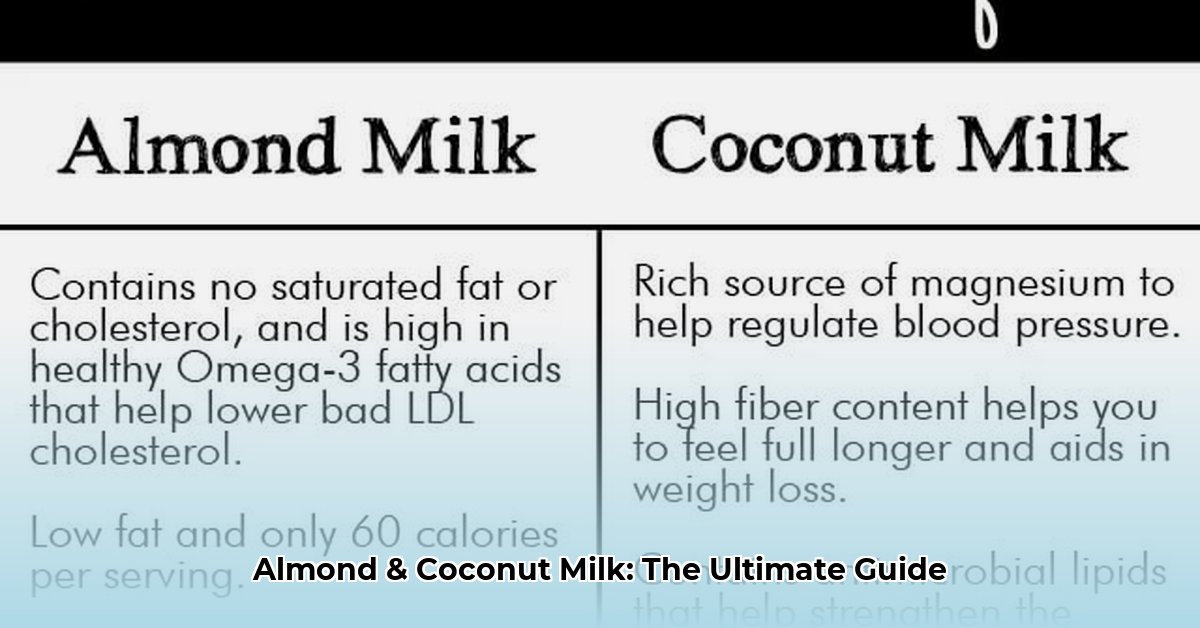
Almond Milk vs. Coconut Milk: A Comparative Review
Choosing between almond and coconut milk can be confusing. Both offer delicious dairy-free alternatives, but their nutritional profiles, environmental impacts, and culinary applications differ significantly. This guide provides a comprehensive comparison to help you make an informed decision.
Nutritional Showdown: A Detailed Comparison
Both almond and coconut milk offer nutritional benefits, but their strengths lie in different areas. Almond milk generally boasts fewer calories and less fat, making it a suitable option for those watching their weight. It's also a good source of vitamin E, a powerful antioxidant. Conversely, coconut milk is richer and creamier, packed with medium-chain triglycerides (MCTs) – fats that are quickly digested and may offer sustained energy. However, more research is needed to fully understand the long-term metabolic effects of MCTs.
Did you know? The nutritional content of both almond and coconut milk varies significantly depending on the brand and whether it's been fortified. Always check the nutrition label!
| Feature | Almond Milk | Coconut Milk |
|---|---|---|
| Calories (per cup) | Typically lower (around 30-60) | Typically higher (around 45-100+) |
| Fat (per cup) | Generally lower, mostly unsaturated | Generally higher, saturated fat prominent |
| Protein (per cup) | Usually lower | Often higher |
| Vitamin E | Good source | Lower |
| MCTs | Minimal to none | Significant amounts |
| Calcium | Often fortified | Often fortified |
| Vitamin D | Often fortified | Often fortified |
Texture and Taste: A Matter of Preference
Texture plays a significant role in choosing between these milks. Almond milk typically has a thinner, lighter consistency, ideal for beverages like lattes and smoothies. Its flavor is subtly nutty and blends easily into various recipes. In contrast, coconut milk possesses a remarkably thick, creamy texture, better suited for adding richness to soups, sauces, and desserts. Its distinctive sweet, tropical taste is a key component of many Southeast Asian dishes.
Sustainability: Assessing Environmental Impact
Both almond and coconut milk production face environmental concerns. Almond cultivation, particularly in arid regions, necessitates significant water consumption. Conversely, large-scale coconut farming is linked to deforestation and habitat loss. Although both have lower greenhouse gas emissions than dairy milk, choosing sustainably sourced products is vital. Look for certifications like Fair Trade, organic, and Rainforest Alliance to support responsible practices.
"Consumers should actively seek out brands committed to sustainable farming practices and transparent sourcing," says Dr. Elena Ramirez, a leading environmental scientist at the University of California, Berkeley.
Fortification: Nutrient Enhancement
Many brands fortify both almond and coconut milk with essential nutrients like calcium and vitamin D. This fortification improves their nutritional profile, making them comparable to dairy milk in terms of key vitamins and minerals. However, the amount of added nutrients can vary greatly between brands. Therefore, it's crucial to check the nutrition facts panel before purchasing.
Culinary Applications: Versatile Use in the Kitchen
Both almond and coconut milk offer incredible versatility in cooking. Almond milk’s subtle flavor works well in baking, adding a light nutty touch to cakes and muffins. Its thinner consistency also makes it suitable for creamy soups and sauces. Coconut milk, with its rich texture and distinct taste, excels in curries, soups, and desserts. Its creaminess elevates the flavor profile of various dishes, acting as a base for numerous sauces and desserts.
"The possibilities are endless!" exclaims Chef Anya Petrova, a renowned plant-based chef based in New York City, emphasizing the versatility of both milks in diverse culinary applications.
Making the Right Choice: A Personalized Decision
Ultimately, the "best" milk depends on individual preferences, dietary needs, and environmental concerns. Consider your health goals, preferred taste and texture, and commitment to sustainable consumption. Both almond and coconut milk offer valuable contributions to a healthy and diverse diet.
Actionable Steps for Choosing Your Milk:
- Assess your dietary needs: Are you watching your calorie or fat intake? Do you need extra calcium or vitamin D?
- Consider your taste preferences: Do you prefer a light and nutty flavor (almond) or a rich and creamy taste (coconut)?
- Prioritize sustainability: Look for brands with certifications indicating responsible sourcing and environmentally friendly practices.
- Read nutrition labels carefully: Compare calorie, fat, protein, and vitamin content to find the best fit for your nutritional needs.
- Experiment in the kitchen: Try both almond and coconut milk in various recipes to discover their unique culinary versatility.
By following these steps and considering the information provided in this guide, you can confidently select the plant-based milk that best suits your individual needs and preferences.